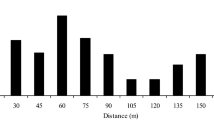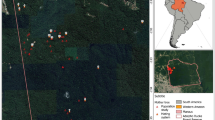Abstract
Microsatellites were used to evaluate the mating system of the remaining trees in a logged population of Swietenia macrophylla, a highly valuable and threatened hardwood species, in the Brazilian Amazon. A total of 25 open pollinated progeny arrays of 16 individuals, with their mother trees, were genotyped using eight highly polymorphic microsatellite loci. Genotypic data analysis from the progeny arrays showed that 373 out of the 400 seedlings (93.25%) were unambiguously the result of outcrossed matings and that the remaining 6.75% had genotypes consistent with self-fertilisation. Apomixis could be ruled out, since none of the 400 seedlings analysed had a multi-locus genotype identical to its mother tree. The high estimate of the multi-locus outcrossing rate (t m = 0.938 ± 0.009) using the mixed mating model also indicated that the population in this remnant stand of S. macrophylla was predominantly allogamous. The relatively large difference between the multi-locus and single-locus outcrossing estimates (t m −t s = 0.117 ± 0.011) provides evidence that, in spite of the high outcrossing rate, a considerable degree of biparental inbreeding has contributed to the genetic structure of this population. Levels of outcrossing were not evenly distributed among maternal trees (t m ranging from 0.39 to 1.00), suggesting the occurrence of a variable degree of self-incompatibility and/or dichogamy among individual trees of this monoecious species. Due to its generalist pollination system and some level of tolerance for selfing, S. macrophylla seems to be resilient to environmental disturbances such as those caused by logging, since it sets fruits with predominantly outcrossed seeds even at low stand densities. Therefore, the remaining individuals in logged areas or in relict fragments may be very important for long-term population recovery and genetic conservation programmes.
Similar content being viewed by others
References
Alvarez-Buylla ER, García-Barros R, Lara-Moreno C et al (1996) Demographic and genetic models in conservation biology: applications and perspectives for tropical rain forest tree species. Annu Rev Ecol Syst 27:387–421
Barrett SCH, Husband BC (1990) The genetics of plant migration and colonization. In: Brown AHD, Clegg MT, Kahler AL et al (eds) Plant population genetics, breeding, and genetic resources. Sinauer, Sunderland
Bawa KS (1990) Plant-pollinator interactions in tropical rain forests. Annu Rev Ecol Syst 20:399–422
Boshier DH, Chase MR, Bawa KS (1995) Population genetics of Cordia alliadora (Boraginaceae), a Neotropical tree. 2. Mating system. Am J Bot 82:476–483
Brown AHD, Barrett SCH, Moran GF (1985) Mating system estimation in forest trees: models, methods and meanings. In: Gregorius HR (eds) Population genetics in forestry. Springer, Berlin, Heidelberg, New York
Bush RM, Smouse PE (1992) Evidence for the adaptive significance of allozymes in forest trees. New Forest 6: 179–196
Cloutier D, Kanashiro M, Ciampi AY et al (2007) Impact of selective logging on inbreeding and gene dispersal in an Amazonian tree population of Carapa guianensis Aubl. Mol Ecol 16:797–809
Dayanandan S, Dole J, Bawa K et al (1999) Population structure delineated with microsatellite markers in fragmented populations of a tropical tree, Carapa guianensis (Meliaceae). Mol Ecol 10:1585–1592
Dick CW (2001) Genetic rescue of remnant tropical trees by an alien pollinator. Proc R Soc Lond B 268:2391–2396
Doligez A, Joly HI (1996) Genetic diversity and spatial structure within a natural stand of a tropical forest tree species, Carapa procera (Meliaceae), in French Guyana. Heredity 79:72–82
Doligez A, Joly HI (1997) Mating system of Carapa procera (Meliaceae) in the French Guyana tropical forest. Am J Bot 84:461–470
Doyle JJ, Doyle JL (1987) Isolation of plant DNA from fresh tissue. Focus 12:13–15
Eguiarte LE, Perez-Nasser N, Piñero D (1992) Genetic structure, outcrossing rate and heterosis in Astrocaryum mexicanum (tropical palm): implications for evolution and conservation. Heredity 69:217–228
Federov AA (1966) The structure of the tropical rain forest and speciation in the humid tropics. J Ecol 54:1–11
Gibson JP, Wheelwright NT (1995) Genetic structure in a population of a tropical tree Ocotea tenera (Lauraceae): influence of avian seed dispersal. Oecologia 103:49–54
Gillies ACM, Navarro C, Lowe AJ et al (1999) Genetic diversity in Mesoamerican populations of mahogany (Swietenia macrophylla), assessed using RAPDs. Heredity 83:722–732
Gribel R, Gibbs PE, Queiroz AL (1999) Flowering phenology and pollination biology of Ceiba pentandra (Bombacaceae) in Central Amazonia. J Trop Ecol 15:247–263
Grogan J, Barreto P (2005) Big-leaf mahogany on CITES Appendix II: big challenge, big opportunity. Conserv Biol 19:973–976
Grogan J, Galvão J (2006) Physiographic and floristic gradients across topography in transitional seasonally dry evergreen forests of southeastern Amazonia, Brazil. Act Amazon 36:483–496
Grogan J, Ashton MS, Galvão J (2003) Big-leaf mahogany (Swietenia macrophylla) seedling survival and growth across a topographic gradient in southeast Pará, Brazil. For Ecol Manage 186:311–326
Grogan J, Jennings SB, Landis RM et al (in press) What loggers leave behind: mahogany population structure and potential for recovery in the Brazilian Amazon. For Ecol Manage
Guo SW, Thompson EA (1992) Performing the exact test for Hardy–Weinberg proportions for multiple alleles. Biometrics 48:2868–2872
Hall P, Orrel LC, Bawa KS (1994) Genetic diversity and mating system in a tropical tree, Carapa guianensis (Meliaceae). Am J Bot 81:1104–1111
James T, Vege S, Aldrich P (1998) Mating systems of three tropical dry forest tree species. Biotropica 30:587–594
Jarne P, Lagoda PJL (1996) Microsatellites, from molecules to populations and back. TREE 11:424–429
Lande R, Schemske DW (1985) The evolution of self-fertilization and inbreeding depression in plants. I. Genetics models. Evolution 39:24–40
Lemes MR, Brondani RPV, Grattapaglia D (2002) Multiplexed systems of microsatellite markers for genetic analysis in mahogany, Swietenia macrophylla King (Meliaceae), a threatened Neotropical timber species. J Hered 93:287–291
Lemes MR, Gribel R, Proctor J et al (2003). Population genetic structure of mahogany (Swietenia macrophylla King, Meliaceae) across the Brazilian Amazon, based on variation at microsatellite loci: implications for conservation. Mol Ecol 12:2875–2883
Loveless MD, Gullison RE (2003) Genetic variation in mahogany populations in Bolivia. In: Lugo AE, Figueroa Colon JC, Alayon M (eds) Big-leaf mahogany: genetics, ecology, and management. Springer-Verlag, New York
Loveless MD, Hamrick JL, Foster RB (1998) Population structure and mating system in Tachigali versicolor, a monocarpic Neotropical tree. Heredity 81:134–143
Murawski DA, Hamrick JL (1991) The effect of the density of flowering individuals on the mating systems of nine tropical tree species. Heredity 67:167–174
Murawski DA, Hamrick JL (1992a) The mating system of Cavanillesia platanifolia under extremes of flowering-tree density: a test of predictions. Biotropica 24:99–101
Murawski DA, Hamrick JL (1992b) Mating system and phenology of Ceiba pentandra (Bombacaceae) in Central Panama. J Hered 83:401–404
Murawski DA, Hamrick JL, Hubbell SP et al (1990) Mating systems of two Bombacaceous trees of a Neotropical moist forest. Oecologia 82:501–506
Murawski DA, Dayanandan B, Bawa KS (1994) Outcrossing rates of two endemic Shorea species from Sri Lankan tropical rain forests. Biotropica 26:23–29
Novick RR, Dick CW, Lemes MR et al (2003) Genetic structure of Mesoamerican populations of big-leaf mahogany (Swietenia macrophylla) inferred from microsatellite analyses. Mol Ecol 12:2885–2893
Raymond M, Rousset F (1998) GENEPOP (version 3.1c) an updated version of GENEPOP V.1.2 (1995): population genetics software for exact tests and ecumenicism. J Hered 86:248–249
Ribeiro RA, Lovato MB (2004) Mating system in a neotropical tree species, Senna multijuga (Fabaceae). Gen Mol Biol 27:418–424
Ritland K (1983) Estimation of mating systems. In: Tanksley D, Orton TJ (eds) Isozymes in plant breeding and genetics, part A. Elsevier, Amsterdam
Ritland K (1988) The genetic-mating structure of subdivided populations II. Correlated mating models. Theor Popul Biol 34:320–346
Ritland K (1989) Correlated matings in the partial selfer Mimulus guttatus. Evolution 43:848–859
Ritland K (2002) Extensions of models for the estimation of mating systems using n independent loci. Heredity 88:221–228
Ritland K, El-Kassaby YA (1985) The nature of inbreeding in a seed orchard of Douglas-fir as shown by an efficient multilocus model. Theor Appl Gen 71:375–384
Ritland K, Jain SK (1981) A model for the estimation of outcrossing rate and gene frequencies based on n independent loci. Heredity 47:37–54
Sebbenn AM, Kageyama PY, Siqueira ACMF et al (2000) Mating system in populations of Cariniana legalis Mart. O. Ktze: implications for genetic conservation and improvement. Scientia Forestalis 58:25–40
Shaw DV, Kahler AL, Allard RW (1981) A multilocus estimator of mating system parameters in plant populations. Proc Natl Acad Sci USA 78:1298–1302
Styles BT (1972) The flower biology of the Meliaceae and its bearing on tree breeding. Silvae Gen 21:175–182
Uyenoyama MK (1986) Inbreeding and the cost of meiosis: the evolution of selfing in populations practising biparental inbreeding. Evolution 40:388–404
Ward M, Dick CW, Gribel R et al (2005) To self, or not to self…A review of outcrossing and pollen-mediated gene flow in neotropical trees. Heredity 95:246–254
Weir BS (1996) Genetic data analysis II. Sinauer Associates, Sunderland
Weir BS, Cockerham CC (1984) Estimating F-statistics for the analysis of population structure. Evolution 38:1358–1370
White GM, Boshier DH (1999) Genetic variation within a fragmented population of Swietenia humilis Zucc. Mol Ecol 11:1899–1910
White GM, Boshier DH (2000) Fragmentation in Central American dry forests—genetic impacts on Swietenia humilis. In: Young AG, Clarck G (eds) Genetics, demography and the viability of fragmented populations. Cambridge University Press, Cambridge
White GM, Boshier DH, Powell W (2002) Increased pollen flow counteracts fragmentation in a tropical dry forest: an example from Swietenia humilis Zuccarini. Proc Natl Acad Sci USA 99:2038–2042
Wright S (1921) Systems of mating II. The effects of inbreeding on the genetic composition of a population. Genetics 6:124–143
Acknowledgements
This study was part of the PhD thesis by the first author at the University of Stirling, UK, and was funded by the Brazilian Ministry of Science and Technology (CNPq/PADCT grant no. 62.00059/97-4 to D.G., CNPq/RHAE fellowship no. 260021/94.6 to M.R.L), World Wildlife Fund (Grant no. CSR 95-033 to M.R.L), and by the Fundação Botânica Margaret Mee. We also acknowledge partial financial support from the European Commission, DG-XII, International Cooperation with Developing Countries Programme, contract number ERBIC18CT970149. Additional support was provided by the USDA Forest Service International Institute of Tropical Forestry and USAID Brazil. Infrastructural support was provided by the timber export companies Serraria Marajoara Ltd (SEMASA) and Madeireira Juary. We thank José Ribeiro for field assistance and Laszlo Nagy for helpful comments and revision of the manuscript.
Author information
Authors and Affiliations
Corresponding author
Rights and permissions
About this article
Cite this article
Lemes, M.R., Grattapaglia, D., Grogan, J. et al. Flexible mating system in a logged population of Swietenia macrophylla King (Meliaceae): implications for the management of a threatened neotropical tree species. Plant Ecol 192, 169–179 (2007). https://doi.org/10.1007/s11258-007-9322-9
Received:
Accepted:
Published:
Issue Date:
DOI: https://doi.org/10.1007/s11258-007-9322-9




